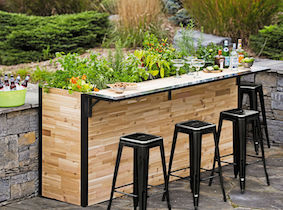Cocktail Gardening
Views: 9311

Have you ever been to a restaurant, ordered a meal, and thought to yourself once the plate came, “Gee, I could make this myself—and maybe a little better, too.” And then a second later the amount of money you could have saved pops into your head, too. The same thing goes for cocktails—with and without alcohol. Many a gardener’s staple are showing up in drinks nowadays. Herbs like mint, rosemary, and cilantro, and even the bigger items like celery, peppers, and cucumbers that make a Bloody Mary a meal.
Growing Cocktail Ingredients at Home
Save yourself the summertime bar tab and tip by growing your cocktail add-ins at home. While growing mint at home is nothing new, the concept of bringing the drink ingredients into a group as a cocktail garden is fairly new. Growing the ingredients in pots near where you’re crafting your cocktails is the most convenient way to create this cocktail garden.
Just snip a sprig from the patio garden, bring it in to your kitchen for a good washing and muddle it into the glass.
The Garden
You can take the cocktail garden a step further by creating an outdoor bar. One of the coolest things I’ve seen recently is from Gardener’s Supply Company—it’s a Plant-a-Bar, pictured above.
The Plant-a-Bar is a raised growing bed, about bar height, with a shelf that acts as a bar. Use the shelf to mix and muddle drinks and appetizers using items harvested right at the bar. It’s large enough to grow bigger plants like tomatoes, peppers and strawberries, too. The shelf folds down when not in use. The Plant-a-Bar can take center stage on a patio, porch or anywhere you entertain.
Things to consider for your cocktail garden experience:
– Grow organically and use a manual method of pest control (i.e. pick them off by hand) before using other forms of control.
– Mind the watering. You want your cocktail ingredients to be fresh and turgid to bring the best flavors to your teas, juleps and tonics.
– Plant the cocktail garden with plenty of variety; include different types of basil, verbena and thyme along with smaller versions of tomatoes, peppers and cucumbers.
– Change out plants regularly. Cilantro is notorious for not lasting long in the garden. That’s okay—remove the fading one and plant with something fresh. That goes for other herbs, too.
Meet Ellen Wells
When you’re raised on a farm, you can’t help but know a thing or two about gardening. Ellen Wells is our expert on edible gardening.…







